Environmental Factors Affecting Nokia's Failure and Types of Competition for Maggi
VerifiedAdded on 2023/06/09
|7
|2397
|80
AI Summary
This article explains how Nokia failed to monitor its marketing environment, leading to its downfall. It also discusses the different types of competition faced by Maggi in the market and the principles of marketing that are crucial for running a business.
Contribute Materials
Your contribution can guide someone’s learning journey. Share your
documents today.
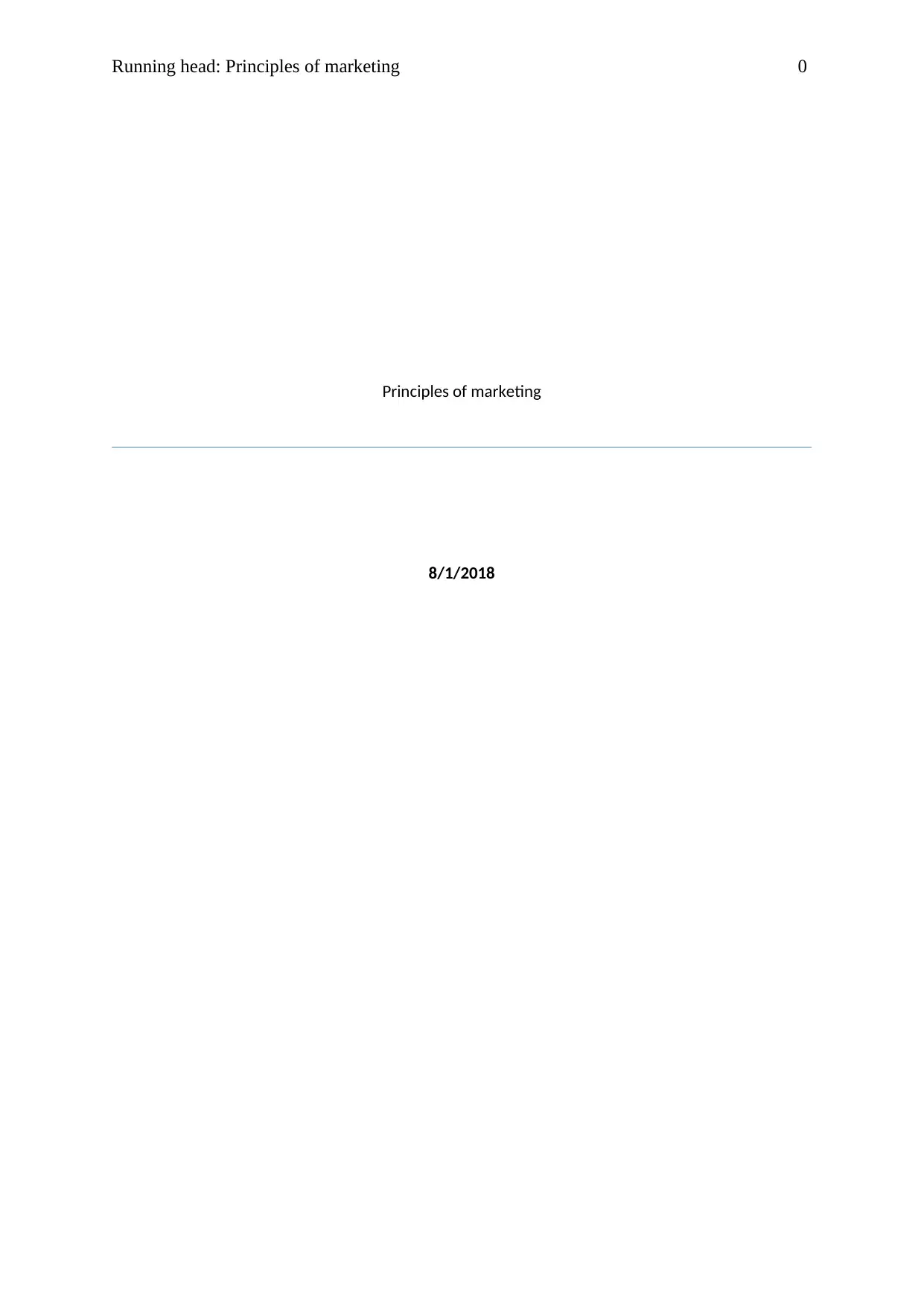
Running head: Principles of marketing 0
Principles of marketing
8/1/2018
Principles of marketing
8/1/2018
Secure Best Marks with AI Grader
Need help grading? Try our AI Grader for instant feedback on your assignments.
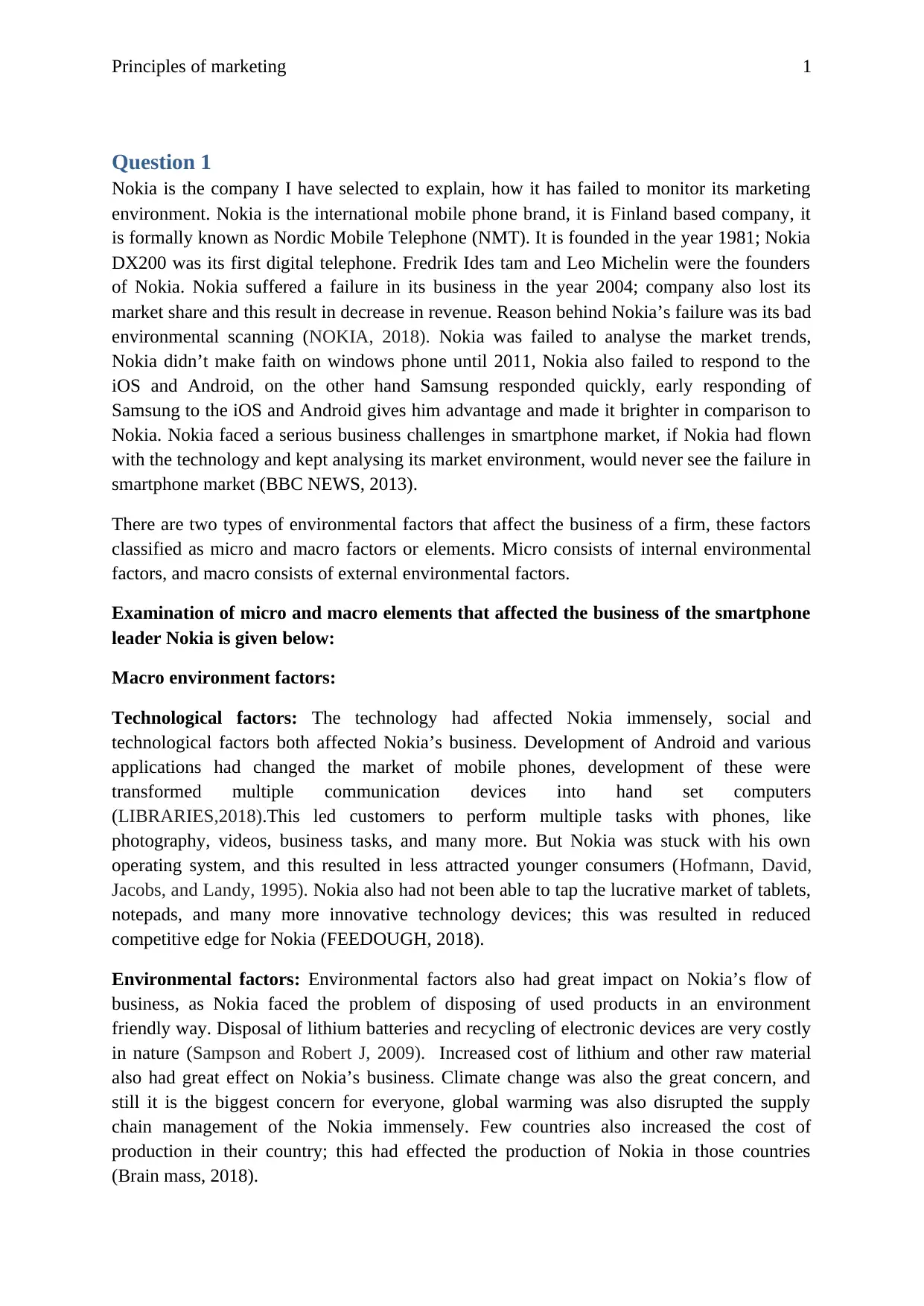
Principles of marketing 1
Question 1
Nokia is the company I have selected to explain, how it has failed to monitor its marketing
environment. Nokia is the international mobile phone brand, it is Finland based company, it
is formally known as Nordic Mobile Telephone (NMT). It is founded in the year 1981; Nokia
DX200 was its first digital telephone. Fredrik Ides tam and Leo Michelin were the founders
of Nokia. Nokia suffered a failure in its business in the year 2004; company also lost its
market share and this result in decrease in revenue. Reason behind Nokia’s failure was its bad
environmental scanning (NOKIA, 2018). Nokia was failed to analyse the market trends,
Nokia didn’t make faith on windows phone until 2011, Nokia also failed to respond to the
iOS and Android, on the other hand Samsung responded quickly, early responding of
Samsung to the iOS and Android gives him advantage and made it brighter in comparison to
Nokia. Nokia faced a serious business challenges in smartphone market, if Nokia had flown
with the technology and kept analysing its market environment, would never see the failure in
smartphone market (BBC NEWS, 2013).
There are two types of environmental factors that affect the business of a firm, these factors
classified as micro and macro factors or elements. Micro consists of internal environmental
factors, and macro consists of external environmental factors.
Examination of micro and macro elements that affected the business of the smartphone
leader Nokia is given below:
Macro environment factors:
Technological factors: The technology had affected Nokia immensely, social and
technological factors both affected Nokia’s business. Development of Android and various
applications had changed the market of mobile phones, development of these were
transformed multiple communication devices into hand set computers
(LIBRARIES,2018).This led customers to perform multiple tasks with phones, like
photography, videos, business tasks, and many more. But Nokia was stuck with his own
operating system, and this resulted in less attracted younger consumers (Hofmann, David,
Jacobs, and Landy, 1995). Nokia also had not been able to tap the lucrative market of tablets,
notepads, and many more innovative technology devices; this was resulted in reduced
competitive edge for Nokia (FEEDOUGH, 2018).
Environmental factors: Environmental factors also had great impact on Nokia’s flow of
business, as Nokia faced the problem of disposing of used products in an environment
friendly way. Disposal of lithium batteries and recycling of electronic devices are very costly
in nature (Sampson and Robert J, 2009). Increased cost of lithium and other raw material
also had great effect on Nokia’s business. Climate change was also the great concern, and
still it is the biggest concern for everyone, global warming was also disrupted the supply
chain management of the Nokia immensely. Few countries also increased the cost of
production in their country; this had effected the production of Nokia in those countries
(Brain mass, 2018).
Question 1
Nokia is the company I have selected to explain, how it has failed to monitor its marketing
environment. Nokia is the international mobile phone brand, it is Finland based company, it
is formally known as Nordic Mobile Telephone (NMT). It is founded in the year 1981; Nokia
DX200 was its first digital telephone. Fredrik Ides tam and Leo Michelin were the founders
of Nokia. Nokia suffered a failure in its business in the year 2004; company also lost its
market share and this result in decrease in revenue. Reason behind Nokia’s failure was its bad
environmental scanning (NOKIA, 2018). Nokia was failed to analyse the market trends,
Nokia didn’t make faith on windows phone until 2011, Nokia also failed to respond to the
iOS and Android, on the other hand Samsung responded quickly, early responding of
Samsung to the iOS and Android gives him advantage and made it brighter in comparison to
Nokia. Nokia faced a serious business challenges in smartphone market, if Nokia had flown
with the technology and kept analysing its market environment, would never see the failure in
smartphone market (BBC NEWS, 2013).
There are two types of environmental factors that affect the business of a firm, these factors
classified as micro and macro factors or elements. Micro consists of internal environmental
factors, and macro consists of external environmental factors.
Examination of micro and macro elements that affected the business of the smartphone
leader Nokia is given below:
Macro environment factors:
Technological factors: The technology had affected Nokia immensely, social and
technological factors both affected Nokia’s business. Development of Android and various
applications had changed the market of mobile phones, development of these were
transformed multiple communication devices into hand set computers
(LIBRARIES,2018).This led customers to perform multiple tasks with phones, like
photography, videos, business tasks, and many more. But Nokia was stuck with his own
operating system, and this resulted in less attracted younger consumers (Hofmann, David,
Jacobs, and Landy, 1995). Nokia also had not been able to tap the lucrative market of tablets,
notepads, and many more innovative technology devices; this was resulted in reduced
competitive edge for Nokia (FEEDOUGH, 2018).
Environmental factors: Environmental factors also had great impact on Nokia’s flow of
business, as Nokia faced the problem of disposing of used products in an environment
friendly way. Disposal of lithium batteries and recycling of electronic devices are very costly
in nature (Sampson and Robert J, 2009). Increased cost of lithium and other raw material
also had great effect on Nokia’s business. Climate change was also the great concern, and
still it is the biggest concern for everyone, global warming was also disrupted the supply
chain management of the Nokia immensely. Few countries also increased the cost of
production in their country; this had effected the production of Nokia in those countries
(Brain mass, 2018).
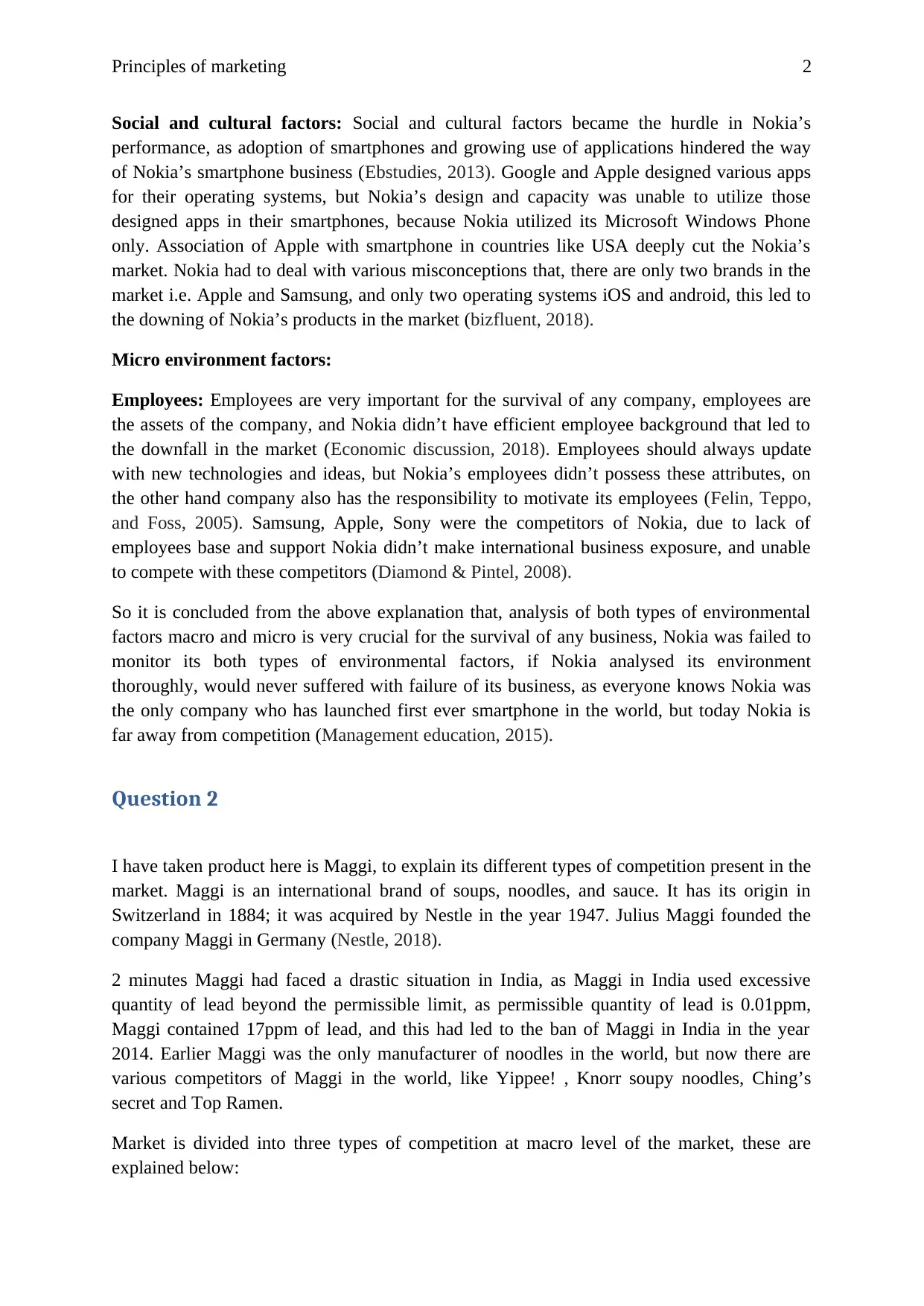
Principles of marketing 2
Social and cultural factors: Social and cultural factors became the hurdle in Nokia’s
performance, as adoption of smartphones and growing use of applications hindered the way
of Nokia’s smartphone business (Ebstudies, 2013). Google and Apple designed various apps
for their operating systems, but Nokia’s design and capacity was unable to utilize those
designed apps in their smartphones, because Nokia utilized its Microsoft Windows Phone
only. Association of Apple with smartphone in countries like USA deeply cut the Nokia’s
market. Nokia had to deal with various misconceptions that, there are only two brands in the
market i.e. Apple and Samsung, and only two operating systems iOS and android, this led to
the downing of Nokia’s products in the market (bizfluent, 2018).
Micro environment factors:
Employees: Employees are very important for the survival of any company, employees are
the assets of the company, and Nokia didn’t have efficient employee background that led to
the downfall in the market (Economic discussion, 2018). Employees should always update
with new technologies and ideas, but Nokia’s employees didn’t possess these attributes, on
the other hand company also has the responsibility to motivate its employees (Felin, Teppo,
and Foss, 2005). Samsung, Apple, Sony were the competitors of Nokia, due to lack of
employees base and support Nokia didn’t make international business exposure, and unable
to compete with these competitors (Diamond & Pintel, 2008).
So it is concluded from the above explanation that, analysis of both types of environmental
factors macro and micro is very crucial for the survival of any business, Nokia was failed to
monitor its both types of environmental factors, if Nokia analysed its environment
thoroughly, would never suffered with failure of its business, as everyone knows Nokia was
the only company who has launched first ever smartphone in the world, but today Nokia is
far away from competition (Management education, 2015).
Question 2
I have taken product here is Maggi, to explain its different types of competition present in the
market. Maggi is an international brand of soups, noodles, and sauce. It has its origin in
Switzerland in 1884; it was acquired by Nestle in the year 1947. Julius Maggi founded the
company Maggi in Germany (Nestle, 2018).
2 minutes Maggi had faced a drastic situation in India, as Maggi in India used excessive
quantity of lead beyond the permissible limit, as permissible quantity of lead is 0.01ppm,
Maggi contained 17ppm of lead, and this had led to the ban of Maggi in India in the year
2014. Earlier Maggi was the only manufacturer of noodles in the world, but now there are
various competitors of Maggi in the world, like Yippee! , Knorr soupy noodles, Ching’s
secret and Top Ramen.
Market is divided into three types of competition at macro level of the market, these are
explained below:
Social and cultural factors: Social and cultural factors became the hurdle in Nokia’s
performance, as adoption of smartphones and growing use of applications hindered the way
of Nokia’s smartphone business (Ebstudies, 2013). Google and Apple designed various apps
for their operating systems, but Nokia’s design and capacity was unable to utilize those
designed apps in their smartphones, because Nokia utilized its Microsoft Windows Phone
only. Association of Apple with smartphone in countries like USA deeply cut the Nokia’s
market. Nokia had to deal with various misconceptions that, there are only two brands in the
market i.e. Apple and Samsung, and only two operating systems iOS and android, this led to
the downing of Nokia’s products in the market (bizfluent, 2018).
Micro environment factors:
Employees: Employees are very important for the survival of any company, employees are
the assets of the company, and Nokia didn’t have efficient employee background that led to
the downfall in the market (Economic discussion, 2018). Employees should always update
with new technologies and ideas, but Nokia’s employees didn’t possess these attributes, on
the other hand company also has the responsibility to motivate its employees (Felin, Teppo,
and Foss, 2005). Samsung, Apple, Sony were the competitors of Nokia, due to lack of
employees base and support Nokia didn’t make international business exposure, and unable
to compete with these competitors (Diamond & Pintel, 2008).
So it is concluded from the above explanation that, analysis of both types of environmental
factors macro and micro is very crucial for the survival of any business, Nokia was failed to
monitor its both types of environmental factors, if Nokia analysed its environment
thoroughly, would never suffered with failure of its business, as everyone knows Nokia was
the only company who has launched first ever smartphone in the world, but today Nokia is
far away from competition (Management education, 2015).
Question 2
I have taken product here is Maggi, to explain its different types of competition present in the
market. Maggi is an international brand of soups, noodles, and sauce. It has its origin in
Switzerland in 1884; it was acquired by Nestle in the year 1947. Julius Maggi founded the
company Maggi in Germany (Nestle, 2018).
2 minutes Maggi had faced a drastic situation in India, as Maggi in India used excessive
quantity of lead beyond the permissible limit, as permissible quantity of lead is 0.01ppm,
Maggi contained 17ppm of lead, and this had led to the ban of Maggi in India in the year
2014. Earlier Maggi was the only manufacturer of noodles in the world, but now there are
various competitors of Maggi in the world, like Yippee! , Knorr soupy noodles, Ching’s
secret and Top Ramen.
Market is divided into three types of competition at macro level of the market, these are
explained below:
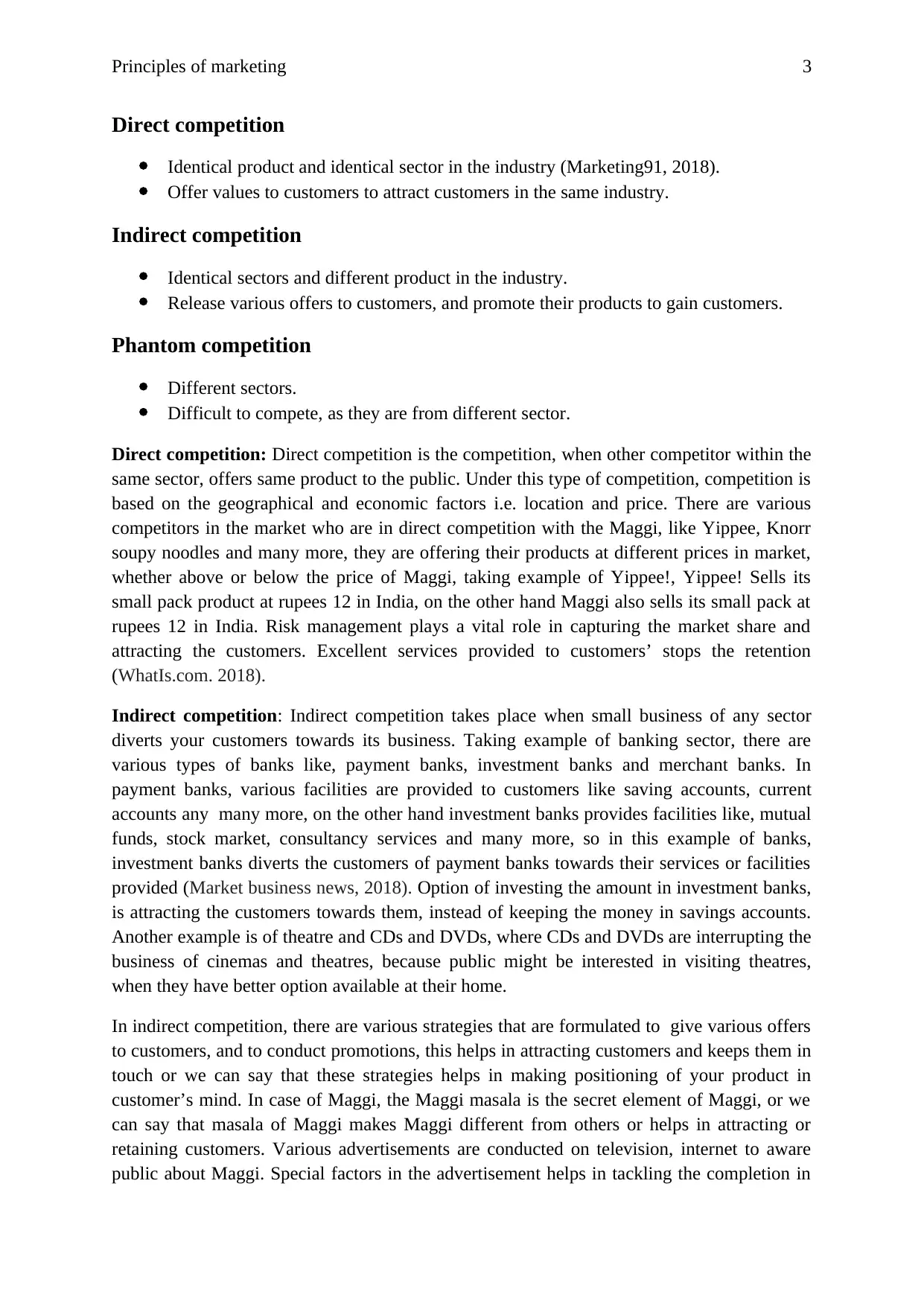
Principles of marketing 3
Direct competition
Identical product and identical sector in the industry (Marketing91, 2018).
Offer values to customers to attract customers in the same industry.
Indirect competition
Identical sectors and different product in the industry.
Release various offers to customers, and promote their products to gain customers.
Phantom competition
Different sectors.
Difficult to compete, as they are from different sector.
Direct competition: Direct competition is the competition, when other competitor within the
same sector, offers same product to the public. Under this type of competition, competition is
based on the geographical and economic factors i.e. location and price. There are various
competitors in the market who are in direct competition with the Maggi, like Yippee, Knorr
soupy noodles and many more, they are offering their products at different prices in market,
whether above or below the price of Maggi, taking example of Yippee!, Yippee! Sells its
small pack product at rupees 12 in India, on the other hand Maggi also sells its small pack at
rupees 12 in India. Risk management plays a vital role in capturing the market share and
attracting the customers. Excellent services provided to customers’ stops the retention
(WhatIs.com. 2018).
Indirect competition: Indirect competition takes place when small business of any sector
diverts your customers towards its business. Taking example of banking sector, there are
various types of banks like, payment banks, investment banks and merchant banks. In
payment banks, various facilities are provided to customers like saving accounts, current
accounts any many more, on the other hand investment banks provides facilities like, mutual
funds, stock market, consultancy services and many more, so in this example of banks,
investment banks diverts the customers of payment banks towards their services or facilities
provided (Market business news, 2018). Option of investing the amount in investment banks,
is attracting the customers towards them, instead of keeping the money in savings accounts.
Another example is of theatre and CDs and DVDs, where CDs and DVDs are interrupting the
business of cinemas and theatres, because public might be interested in visiting theatres,
when they have better option available at their home.
In indirect competition, there are various strategies that are formulated to give various offers
to customers, and to conduct promotions, this helps in attracting customers and keeps them in
touch or we can say that these strategies helps in making positioning of your product in
customer’s mind. In case of Maggi, the Maggi masala is the secret element of Maggi, or we
can say that masala of Maggi makes Maggi different from others or helps in attracting or
retaining customers. Various advertisements are conducted on television, internet to aware
public about Maggi. Special factors in the advertisement helps in tackling the completion in
Direct competition
Identical product and identical sector in the industry (Marketing91, 2018).
Offer values to customers to attract customers in the same industry.
Indirect competition
Identical sectors and different product in the industry.
Release various offers to customers, and promote their products to gain customers.
Phantom competition
Different sectors.
Difficult to compete, as they are from different sector.
Direct competition: Direct competition is the competition, when other competitor within the
same sector, offers same product to the public. Under this type of competition, competition is
based on the geographical and economic factors i.e. location and price. There are various
competitors in the market who are in direct competition with the Maggi, like Yippee, Knorr
soupy noodles and many more, they are offering their products at different prices in market,
whether above or below the price of Maggi, taking example of Yippee!, Yippee! Sells its
small pack product at rupees 12 in India, on the other hand Maggi also sells its small pack at
rupees 12 in India. Risk management plays a vital role in capturing the market share and
attracting the customers. Excellent services provided to customers’ stops the retention
(WhatIs.com. 2018).
Indirect competition: Indirect competition takes place when small business of any sector
diverts your customers towards its business. Taking example of banking sector, there are
various types of banks like, payment banks, investment banks and merchant banks. In
payment banks, various facilities are provided to customers like saving accounts, current
accounts any many more, on the other hand investment banks provides facilities like, mutual
funds, stock market, consultancy services and many more, so in this example of banks,
investment banks diverts the customers of payment banks towards their services or facilities
provided (Market business news, 2018). Option of investing the amount in investment banks,
is attracting the customers towards them, instead of keeping the money in savings accounts.
Another example is of theatre and CDs and DVDs, where CDs and DVDs are interrupting the
business of cinemas and theatres, because public might be interested in visiting theatres,
when they have better option available at their home.
In indirect competition, there are various strategies that are formulated to give various offers
to customers, and to conduct promotions, this helps in attracting customers and keeps them in
touch or we can say that these strategies helps in making positioning of your product in
customer’s mind. In case of Maggi, the Maggi masala is the secret element of Maggi, or we
can say that masala of Maggi makes Maggi different from others or helps in attracting or
retaining customers. Various advertisements are conducted on television, internet to aware
public about Maggi. Special factors in the advertisement helps in tackling the completion in
Secure Best Marks with AI Grader
Need help grading? Try our AI Grader for instant feedback on your assignments.
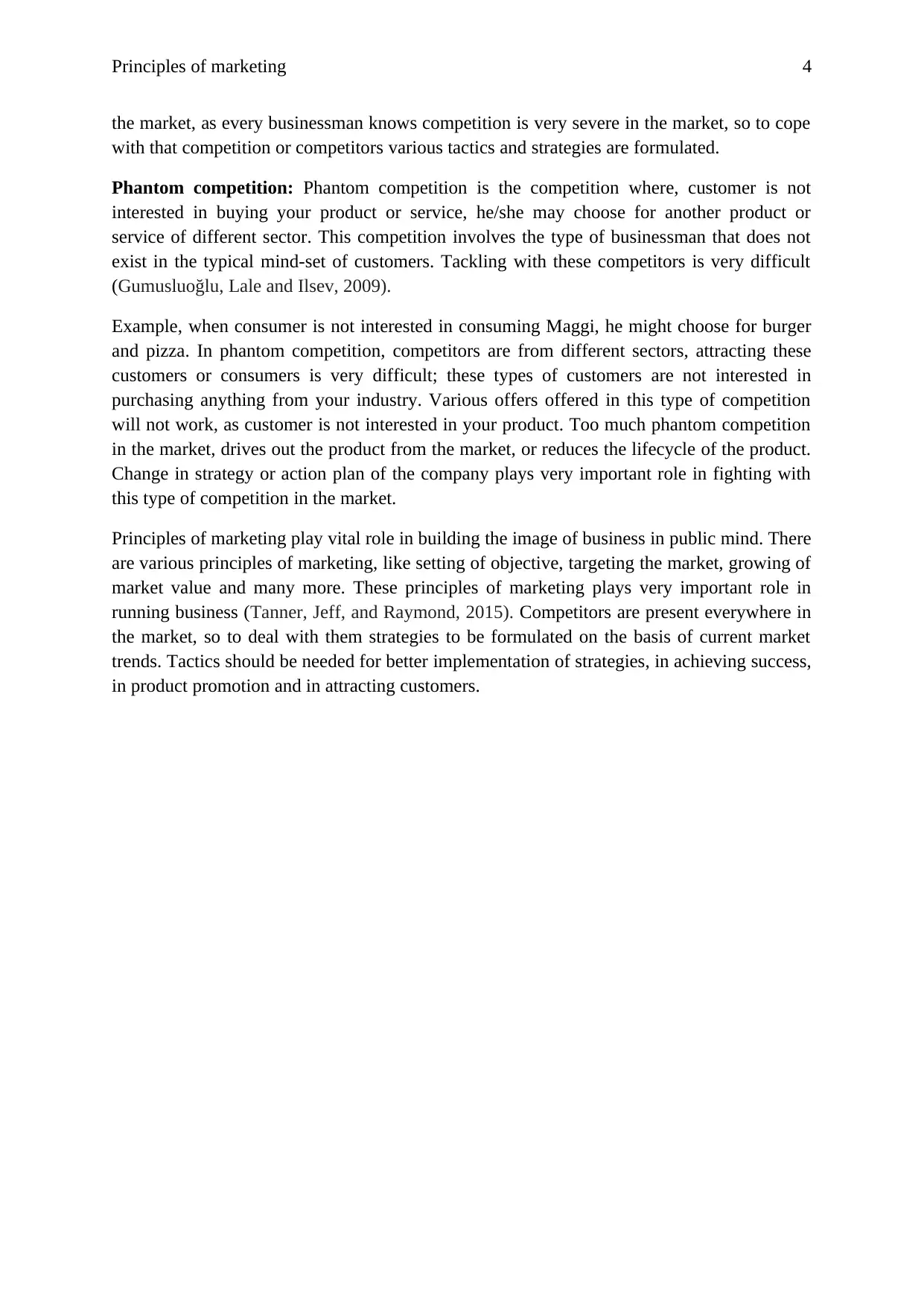
Principles of marketing 4
the market, as every businessman knows competition is very severe in the market, so to cope
with that competition or competitors various tactics and strategies are formulated.
Phantom competition: Phantom competition is the competition where, customer is not
interested in buying your product or service, he/she may choose for another product or
service of different sector. This competition involves the type of businessman that does not
exist in the typical mind-set of customers. Tackling with these competitors is very difficult
(Gumusluoğlu, Lale and Ilsev, 2009).
Example, when consumer is not interested in consuming Maggi, he might choose for burger
and pizza. In phantom competition, competitors are from different sectors, attracting these
customers or consumers is very difficult; these types of customers are not interested in
purchasing anything from your industry. Various offers offered in this type of competition
will not work, as customer is not interested in your product. Too much phantom competition
in the market, drives out the product from the market, or reduces the lifecycle of the product.
Change in strategy or action plan of the company plays very important role in fighting with
this type of competition in the market.
Principles of marketing play vital role in building the image of business in public mind. There
are various principles of marketing, like setting of objective, targeting the market, growing of
market value and many more. These principles of marketing plays very important role in
running business (Tanner, Jeff, and Raymond, 2015). Competitors are present everywhere in
the market, so to deal with them strategies to be formulated on the basis of current market
trends. Tactics should be needed for better implementation of strategies, in achieving success,
in product promotion and in attracting customers.
the market, as every businessman knows competition is very severe in the market, so to cope
with that competition or competitors various tactics and strategies are formulated.
Phantom competition: Phantom competition is the competition where, customer is not
interested in buying your product or service, he/she may choose for another product or
service of different sector. This competition involves the type of businessman that does not
exist in the typical mind-set of customers. Tackling with these competitors is very difficult
(Gumusluoğlu, Lale and Ilsev, 2009).
Example, when consumer is not interested in consuming Maggi, he might choose for burger
and pizza. In phantom competition, competitors are from different sectors, attracting these
customers or consumers is very difficult; these types of customers are not interested in
purchasing anything from your industry. Various offers offered in this type of competition
will not work, as customer is not interested in your product. Too much phantom competition
in the market, drives out the product from the market, or reduces the lifecycle of the product.
Change in strategy or action plan of the company plays very important role in fighting with
this type of competition in the market.
Principles of marketing play vital role in building the image of business in public mind. There
are various principles of marketing, like setting of objective, targeting the market, growing of
market value and many more. These principles of marketing plays very important role in
running business (Tanner, Jeff, and Raymond, 2015). Competitors are present everywhere in
the market, so to deal with them strategies to be formulated on the basis of current market
trends. Tactics should be needed for better implementation of strategies, in achieving success,
in product promotion and in attracting customers.
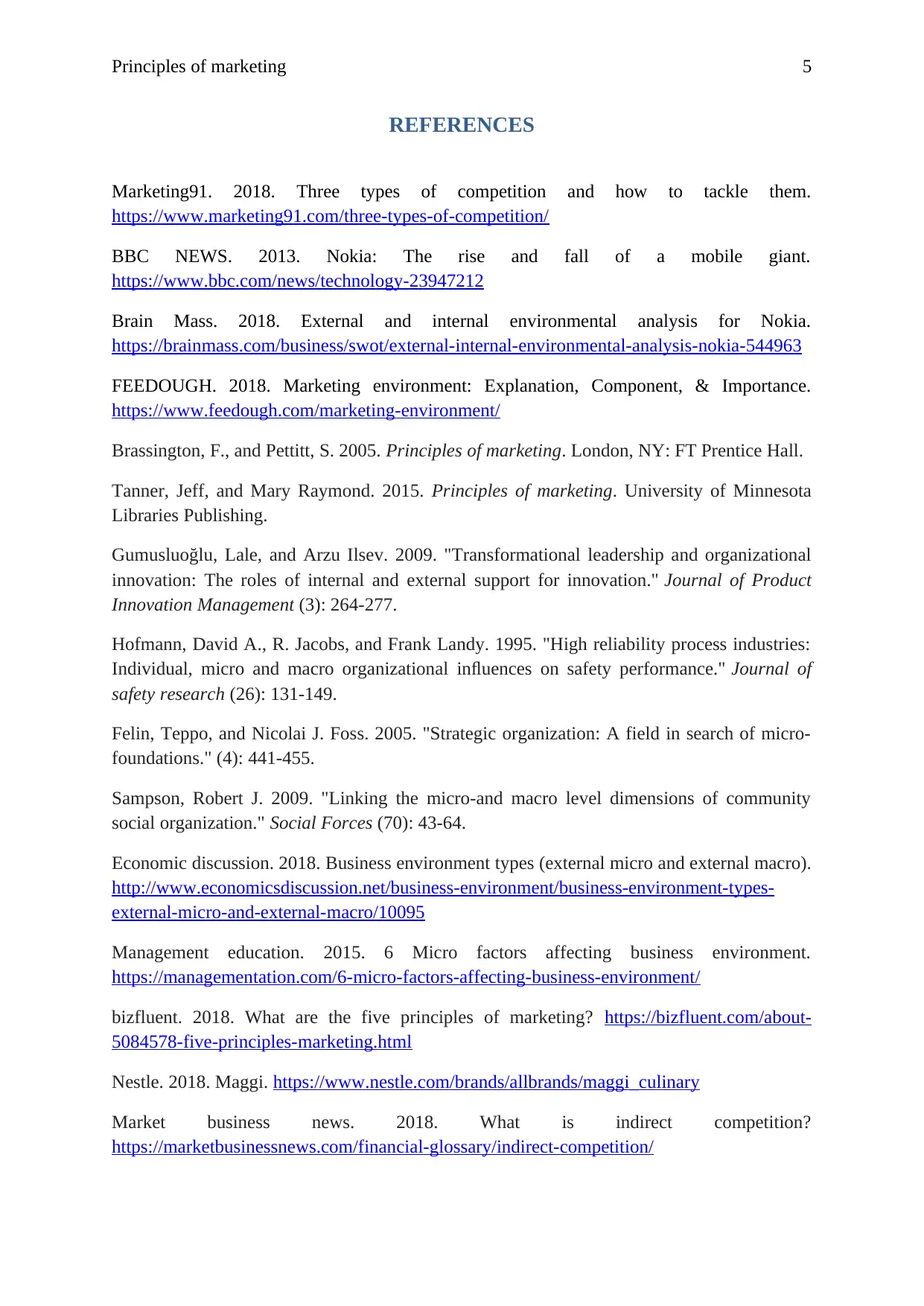
Principles of marketing 5
REFERENCES
Marketing91. 2018. Three types of competition and how to tackle them.
https://www.marketing91.com/three-types-of-competition/
BBC NEWS. 2013. Nokia: The rise and fall of a mobile giant.
https://www.bbc.com/news/technology-23947212
Brain Mass. 2018. External and internal environmental analysis for Nokia.
https://brainmass.com/business/swot/external-internal-environmental-analysis-nokia-544963
FEEDOUGH. 2018. Marketing environment: Explanation, Component, & Importance.
https://www.feedough.com/marketing-environment/
Brassington, F., and Pettitt, S. 2005. Principles of marketing. London, NY: FT Prentice Hall.
Tanner, Jeff, and Mary Raymond. 2015. Principles of marketing. University of Minnesota
Libraries Publishing.
Gumusluoğlu, Lale, and Arzu Ilsev. 2009. "Transformational leadership and organizational
innovation: The roles of internal and external support for innovation." Journal of Product
Innovation Management (3): 264-277.
Hofmann, David A., R. Jacobs, and Frank Landy. 1995. "High reliability process industries:
Individual, micro and macro organizational influences on safety performance." Journal of
safety research (26): 131-149.
Felin, Teppo, and Nicolai J. Foss. 2005. "Strategic organization: A field in search of micro-
foundations." (4): 441-455.
Sampson, Robert J. 2009. "Linking the micro-and macro level dimensions of community
social organization." Social Forces (70): 43-64.
Economic discussion. 2018. Business environment types (external micro and external macro).
http://www.economicsdiscussion.net/business-environment/business-environment-types-
external-micro-and-external-macro/10095
Management education. 2015. 6 Micro factors affecting business environment.
https://managementation.com/6-micro-factors-affecting-business-environment/
bizfluent. 2018. What are the five principles of marketing? https://bizfluent.com/about-
5084578-five-principles-marketing.html
Nestle. 2018. Maggi. https://www.nestle.com/brands/allbrands/maggi_culinary
Market business news. 2018. What is indirect competition?
https://marketbusinessnews.com/financial-glossary/indirect-competition/
REFERENCES
Marketing91. 2018. Three types of competition and how to tackle them.
https://www.marketing91.com/three-types-of-competition/
BBC NEWS. 2013. Nokia: The rise and fall of a mobile giant.
https://www.bbc.com/news/technology-23947212
Brain Mass. 2018. External and internal environmental analysis for Nokia.
https://brainmass.com/business/swot/external-internal-environmental-analysis-nokia-544963
FEEDOUGH. 2018. Marketing environment: Explanation, Component, & Importance.
https://www.feedough.com/marketing-environment/
Brassington, F., and Pettitt, S. 2005. Principles of marketing. London, NY: FT Prentice Hall.
Tanner, Jeff, and Mary Raymond. 2015. Principles of marketing. University of Minnesota
Libraries Publishing.
Gumusluoğlu, Lale, and Arzu Ilsev. 2009. "Transformational leadership and organizational
innovation: The roles of internal and external support for innovation." Journal of Product
Innovation Management (3): 264-277.
Hofmann, David A., R. Jacobs, and Frank Landy. 1995. "High reliability process industries:
Individual, micro and macro organizational influences on safety performance." Journal of
safety research (26): 131-149.
Felin, Teppo, and Nicolai J. Foss. 2005. "Strategic organization: A field in search of micro-
foundations." (4): 441-455.
Sampson, Robert J. 2009. "Linking the micro-and macro level dimensions of community
social organization." Social Forces (70): 43-64.
Economic discussion. 2018. Business environment types (external micro and external macro).
http://www.economicsdiscussion.net/business-environment/business-environment-types-
external-micro-and-external-macro/10095
Management education. 2015. 6 Micro factors affecting business environment.
https://managementation.com/6-micro-factors-affecting-business-environment/
bizfluent. 2018. What are the five principles of marketing? https://bizfluent.com/about-
5084578-five-principles-marketing.html
Nestle. 2018. Maggi. https://www.nestle.com/brands/allbrands/maggi_culinary
Market business news. 2018. What is indirect competition?
https://marketbusinessnews.com/financial-glossary/indirect-competition/
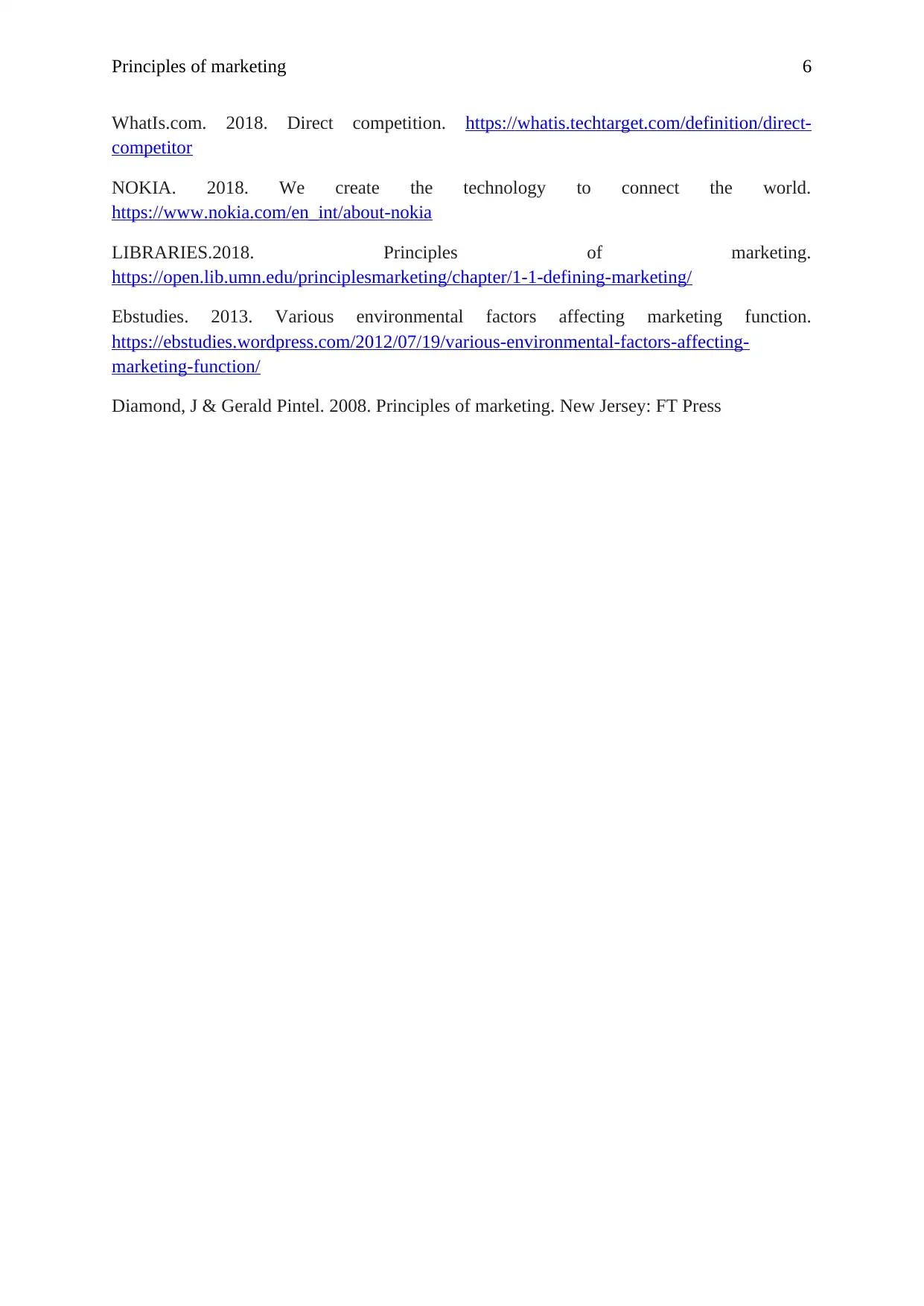
Principles of marketing 6
WhatIs.com. 2018. Direct competition. https://whatis.techtarget.com/definition/direct-
competitor
NOKIA. 2018. We create the technology to connect the world.
https://www.nokia.com/en_int/about-nokia
LIBRARIES.2018. Principles of marketing.
https://open.lib.umn.edu/principlesmarketing/chapter/1-1-defining-marketing/
Ebstudies. 2013. Various environmental factors affecting marketing function.
https://ebstudies.wordpress.com/2012/07/19/various-environmental-factors-affecting-
marketing-function/
Diamond, J & Gerald Pintel. 2008. Principles of marketing. New Jersey: FT Press
WhatIs.com. 2018. Direct competition. https://whatis.techtarget.com/definition/direct-
competitor
NOKIA. 2018. We create the technology to connect the world.
https://www.nokia.com/en_int/about-nokia
LIBRARIES.2018. Principles of marketing.
https://open.lib.umn.edu/principlesmarketing/chapter/1-1-defining-marketing/
Ebstudies. 2013. Various environmental factors affecting marketing function.
https://ebstudies.wordpress.com/2012/07/19/various-environmental-factors-affecting-
marketing-function/
Diamond, J & Gerald Pintel. 2008. Principles of marketing. New Jersey: FT Press
1 out of 7
Related Documents
Your All-in-One AI-Powered Toolkit for Academic Success.
+13062052269
info@desklib.com
Available 24*7 on WhatsApp / Email
![[object Object]](/_next/static/media/star-bottom.7253800d.svg)
Unlock your academic potential
© 2024 | Zucol Services PVT LTD | All rights reserved.




